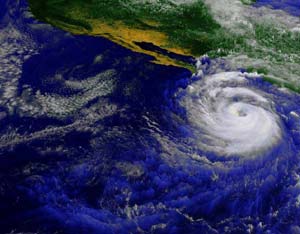Hurricane Winds Carried Ocean Salt & Plankton Far Inland

Hurricane Nora Brings Frozen Plankton to U.S. Plains and Creates Spectacular Halos
Researchers found surprising evidence of sea salt and frozen plankton in high, cold, cirrus clouds, the remnants of Hurricane Nora, over the U.S. plains states. Although the 1997 hurricane was a strong eastern Pacific storm, her high ice-crystal clouds extended many miles inland, carrying ocean phenomena deep into the U.S. heartland.
Kenneth Sassen of the University of Utah, Salt Lake City, and University of Alaska Fairbanks; W. Patrick Arnott of the Desert Research Institute (DRI) in Reno, Nev.; and David O. Starr of NASA’s Goddard Space Flight Center, Greenbelt, Md., co-authored a paper about Hurricane Nora’s far-reaching effects. The paper was published in the April 1, 2003, issue of the American Meteorological Society’s Journal of Atmospheric Sciences.
Scientists were surprised to find what appeared to be frozen plankton in some cirrus crystals collected by research aircraft over Oklahoma, far from the Pacific Ocean. This was the first time examples of microscopic marine life, like plankton, were seen as “nuclei” of ice crystals in the cirrus clouds of a hurricane.
Nora formed off the Panama coast, strengthened as it traveled up the Baja Peninsula, and the hurricane crossed into California in September 1997. Over the western U.S., Nora deposited a stream of high cirrus, ice crystal, clouds that created spectacular optical effects, such as arcs and halos, above a broad region including Utah and Oklahoma. That stream of cirrus clouds enabled researchers to analyze growth of ice crystals from different nuclei.
Different nuclei, like sulfate particles, sea salt and desert dust, affect ice-crystal growth and shape. Torn from the sea surface by strong hurricane winds, sea salt and other particles from evaporated sea spray are carried to the cold upper troposphere in storm updrafts, where the drops freeze and become ice crystals. Plankton, a microscopic organism, is also likely present in the sea spray and is similarly lofted to high levels.
“Understanding how ice crystals grow and what determines their shapes is important in understanding how they interact with sunlight and infrared energy,” Starr noted. “These interactions are important processes in the global climate system. They are also critical to sensing cloud properties from space, where NASA uses measurements of the reflected solar radiation to infer cloud physical properties, such as ice-crystal size,” he said.
Data were gathered using ground-based remote sensors at the Facility for Atmospheric Remote Sensing in Salt Lake City and at the Clouds and Radiation Testbed in northern Oklahoma. A research aircraft collected particle samples over Oklahoma. Observations from the Geostationary Operational Environmental Satellite 9 (West), launched by NASA and operated by the National Oceanic and Atmospheric Administration, were also used. DRI analyzed the ice crystals collected from Nora.
Scientists were using data generated through the U.S. Department of Energy (DOE) Atmospheric Radiation Measurement (ARM) Program. The ARM Program’s purpose is obtaining field measurements and developing computer models of the atmosphere. Researchers hope to better understand the processes that control the transfer of solar and thermal infrared energy in the atmosphere, especially in clouds, and at the Earth’s surface.
The ARM energy measurements also double-check data from the Moderate Imaging Spectroradiometer (MODIS) instrument aboard NASA’s Terra and Aqua satellites. By ensuring the satellites are recording the same energy reflected and absorbed by clouds from Hurricane Nora as those provided by the ground data in this study, scientists hope to take fewer ground measurements in the future, and enable the satellites to provide the data.
The DOE ARM program, National Science Foundation, and NASA’s Earth Science Enterprise funded this research. The Earth Science Enterprise is dedicated to understanding the Earth as an integrated system and applying Earth System Science to improve prediction of climate, weather and natural hazards, such as hurricanes, using the unique vantage point of space.
Media Contact
More Information:
http://www.gsfc.nasa.gov/topstory/2003/0408plankton.htmlAll latest news from the category: Earth Sciences
Earth Sciences (also referred to as Geosciences), which deals with basic issues surrounding our planet, plays a vital role in the area of energy and raw materials supply.
Earth Sciences comprises subjects such as geology, geography, geological informatics, paleontology, mineralogy, petrography, crystallography, geophysics, geodesy, glaciology, cartography, photogrammetry, meteorology and seismology, early-warning systems, earthquake research and polar research.
Newest articles

Parallel Paths: Understanding Malaria Resistance in Chimpanzees and Humans
The closest relatives of humans adapt genetically to habitats and infections Survival of the Fittest: Genetic Adaptations Uncovered in Chimpanzees Görlitz, 10.01.2025. Chimpanzees have genetic adaptations that help them survive…

You are What You Eat—Stanford Study Links Fiber to Anti-Cancer Gene Modulation
The Fiber Gap: A Growing Concern in American Diets Fiber is well known to be an important part of a healthy diet, yet less than 10% of Americans eat the minimum recommended…

Trust Your Gut—RNA-Protein Discovery for Better Immunity
HIRI researchers uncover control mechanisms of polysaccharide utilization in Bacteroides thetaiotaomicron. Researchers at the Helmholtz Institute for RNA-based Infection Research (HIRI) and the Julius-Maximilians-Universität (JMU) in Würzburg have identified a…



